Article and all photos by Joe Mock, BaseballParks.com
All rights reserved
 |
When Ryan Zimmerman hit a home run in the bottom of the ninth in the first regular-season game at Washington’s Nationals Park — triggering the fireworks shown above — not only did it propel his team to a 3-2 Opening Night victory, it also symbolized the arduous journey that the stadium had taken. Every time it looked like Washington had bungled another opportunity to attract a Major League team and provide it with a new park, common sense would suddenly appear and the deal would get back on track.
| Ballpark Stats |
| Team: The National League’s Washington Nationals |
| First game: March 30, 2008, a walk-off 3-2 win over Atlanta for the Nationals |
| Capacity: 41,888 |
| Architects: HOK Sport and Devrouax & Purnell |
| Price: $611 million |
| Home dugout: First base side |
| Field points: East by Northeast |
| Playing surface: Kentucky Bluegrass |
| Betcha didn’t know: During excavation prior to construction, 185,087 cubic yards of the soil was deemed to be contaminated. It had to be “cleaned” before it could be sent to a landfill. |
I’ll save my rant against the District of Columbia until the Summary section of this review. Suffice it to say that the fact that the Washington Nationals now play in an impressive new ballpark is in spite of the local government there. True, they came up with the $611 million to build the place, but they are hardly an example of effective representative government in action.
One aspect of the new park that seemed to get lost in the hoopla of Opening Night is that only two days before, the U.S. Green Building Council bestowed LEED (Leadership in Energy and Environmental Design) Silver Certification status on the park. Now, I look at Nationals Park as being the new standard of what a modern ballpark should be, in nearly all respects. This certification is an incredibly relevant aspect of the story, even though many of these “green” innovations are not obvious to the fans wandering through the ballpark now.
But as future big-league parks are being designed, you can bet that making them “green” (and I’m not talking about the ubiquitous shade of the stadium’s seats, either) will be all the rage. It’s not hard to predict that soon parks will claim to be “greener” than another ballpark, or the “greenest” ever built. Older, less environmentally friendly ballparks will no doubt be green with envy.
So let’s take a look at this new “green” monument on the Washington skyline, looking first at its somewhat-questionable location, then the much-criticized exterior, followed by its nearly perfect interior design, and concluding with its amenities for the fans. And, yes, I’ll have a rant about D.C. at the end!
The Setting
When large cities decide on a location to build a new Major League ballpark, the site selected usually has only one thing going for it: it’s available. It’s usually not in a particularly desirable part of a city (the cost to acquire the land would probably be prohibitive if it were), but the city planners feel that it is at least possible that the area could be revitalized with a big-league venue in it.
Think about what Camden Yards did in concert with the “Inner Harbor” urban renewal in Baltimore. Or what Coors Field did for the Lower Downtown (“LoDo”) area east of the main business district in Denver. Or what PNC Park’s arrival has done for the north shore of Pittsburgh’s downtown area. Or how Petco Park is fitting into all of the development next to San Diego’s Gaslamp Quarter.
But there are also examples where the hoped-for development hasn’t exactly revitalized a dilapidated part of a city’s downtown. Minute Maid Park hasn’t converted the eastern edge of Houston’s downtown into the most desirable spot in Texas — although it’s certainly better than it was before, as now there is a hotel and some restaurants in the area. But it hasn’t attracted the development that the city undoubtedly hoped for. Similarly, Cleveland’s Progressive Field (formerly Jacobs Field) has had less of an impact on its area than the basketball arena nearby.
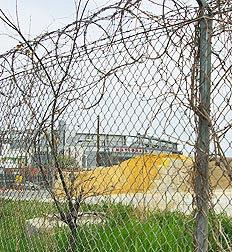 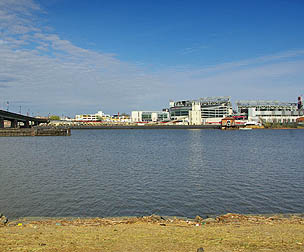 |
So how does Washington’s choice for Nationals Park stack up? The kind response would be “the jury’s still out.” On the negative side, there are a number of elements within a block of the new park that are, putting it bluntly, eyesores (see above left). One Canadian reporter referred to the neighborhood as “an unsightly mess.” The concrete plant directly between the stadium and the Anacostia River is quite ugly — although its proximity to the park certainly was a benefit during construction. There are abandoned lots and, even worse, boarded-up buildings (below center) directly across South Capitol Street from the park itself. Truly, the revitalization of this neighborhood that should have occurred along with the building of the park simply failed to happen.
This is not the fault of the Nationals team or the architects. No, the sole responsibility for this redevelopment lies with the District of Columbia government. And it could — and probably will — still happen. But the surroundings of Nationals Park during its first season are anything but nice.
On the positive side, the location is only a block from the Anacostia (see above right, taken from across the river), which gives fans an interesting view from the concourse of the upper deck behind first base. Also, although parking for non season ticket holders is pretty much non-existent at this point, the location provides moderately good access to I-295 (which becomes the Baltimore-Washington Parkway to the north) just across the river, and to I-395 a few blocks to the north. Also, there is a Metro (subway) station just two blocks north of the center-field gate. Since most fans seem to be arriving by Metro, that is a very good thing. For opening day, by the way, the walk from the Metro station was decorated with arches of balloons (below right), a very nice touch!
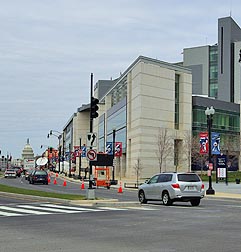 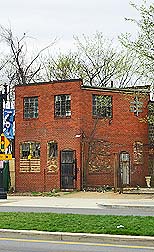  |
Frankly, before MLB struck the deal with the District of Columbia (which then fell apart, and then was brought back to life), I was rooting for a location in Northern Virginia, possibly in Arlington. This would have offered the benefits of being closer to the team’s potential fan base (at least the fan base with higher incomes) and being farther from the financially threatened Orioles of Baltimore. It also would’ve meant not having to deal with the D.C. government. In addition, such a site could’ve provided tremendous views of D.C., which the current site doesn’t offer nearly as well. However, a site in Northern Virginia would also have created traffic problems in an area already nationally famous for its gridlock, plus there were significant environmental concerns and fears about a park’s proximity to Reagan National Airport.
So here it sits, due south of the U.S. Capitol (see above left) in the District of Columbia. One hopes its presence will prompt the kind of positive energy that Coors Field and PNC Park have created in their neighborhoods. Frankly, I don’t think that’s a given.
The Exterior
The authors of several architectural reviews have not been kind to Nationals Park.
In a review entitled “This Diamond Isn’t a Gem” in the Washington Post, author Philip Kennicott states that the stadium “all but fades into the landscape” as it presents “a bland face to the world.” He opines that the park “is also a colossal symbolic failure with national and international import.” After heaping on criticism after criticism, he goes on to provide only one quote from a so-called expert, Neil DeMause of “Field of Schemes” fame. DeMause, it has always appeared to me, lives to loathe every publicly funded sports facility in the nation … so author Kennicott didn’t try at all to find a voice to balance out his own negativity.
Is this scathing criticism justified? Probably not, at least not with the harshness that a number of writers have exhibited.
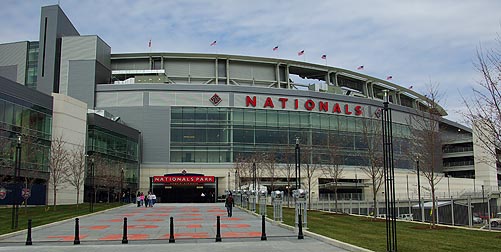 |
I have closely followed the funding, design and construction of this park during the three years leading up to its opening. I have concluded that its exterior is a result of two things: the ridiculous processes and compromises that the architects were forced to endure in dealing with the D.C. government; and the desire to have the structure be compatible with — not stand out from — the other important buildings in our nation’s capital.
I’ll save my ranting and raving about the local government until the end of this review, but we do need to examine how Nationals Park’s exterior “fits” in a city of monuments and Federal buildings.
Unlike ballparks in other cities — especially in the East — where brick and dark building materials predominate, such is not the case in Washington. Think of the color of the Washington Monument, the White House, the Capitol, the East Wing of the National Gallery of Art and the buildings of all of those Federal agencies just a few blocks from the Mall. Would you want your ballpark to have a similar look? I think so.
So precast concrete and stone, in neutral, light shades, was the order of the day. This is especially true of the park’s east (below left), west (below right) and north sides. It bothers me a little that the east and west sides are somewhat dissimilar from each other (not grossly so, but they aren’t identical), but this seems to be a trend in architecture today.
 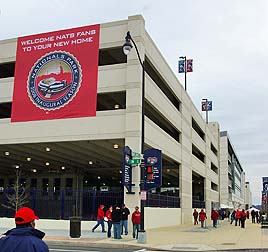 |
And the entryways are also an incredibly important aspect of the park’s exterior, but it’s too bad that the majority of fans enter the park through gates that are not all that special. That entryway is shown in the center photo below. It’s where Half Street (along which fans who’ve just gotten off the Metro walk to the park) intersects N Street on the north side of the stadium. This is very reminiscent of the Braves’ Turner Field, where almost all fans must enter through a series of gates near center field — although the plazas (both inside the gates and out) are larger and offer more features in Atlanta.
Washington’s nicer gates, sadly, don’t get a lot of use. The one closest to home plate (below left) received the most design attention, in that it provides a series of lessons on the history of baseball in the Nation’s Capital, with years embedded in the walkway and markers providing details on the key historical events along the right side as you’re approaching the entrance. The first-base gate (below right) is reached only by climbing impressive steps from the street level.
Perhaps as more development occurs in the area between the park and the river, these entrances will receive more use. I certainly hope so.
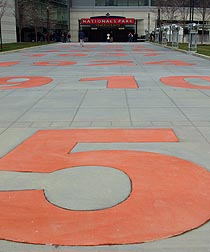 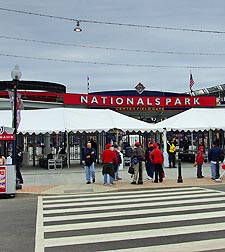 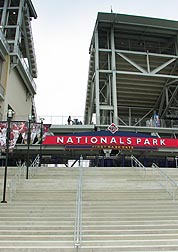 |
Truly, the exterior of Nationals Park isn’t its strongest aspect, but it does do a good job of being compatible with the other key buildings in D.C. — even if the reviewers don’t like it.
The Design
The interior of Nationals Park is its strongest aspect, though. And HOK’s work to make the facility environmentally friendly is without peer in the sports world.
  |
Before we look at just how green Nationals Park is, let’s examine its layout. The part of the interior that most fans will see first is the plaza just inside the gates on the north side of the facility. Again, that’s because most fans enter through those gates as they come from the Metro stations.
That plaza is intelligently designed, much like the ones that are also beyond center field in Atlanta and St. Louis, although of these three, the one at Turner Field has hands down the most attractions for young and old alike. In Washington, this plaza is bounded on two sides by the massive parking garages for season-ticket holders. The ground levels of these structures, though, include a variety of stores and games, and the large souvenir store is right by the gates at the base of the western parking building.
These parking garages, by the way, absolutely dominate the exterior of the park as you approach it from the north. Once inside, though, they aren’t nearly as obtrusive — which is a good thing since they are visible from almost every seat in the ballpark (see the left side of the photo below).
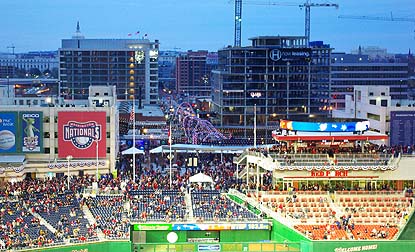 |
Between this plaza and the field is the Red Porch Restaurant (it’s called the Red Loft on its upper level, and is shown on the right side of the photo above), one of a number of dining options at the park — although the other sit-down eateries are reserved for the well-heeled folks in the expensive seats behind home plate and on the Club level. These restaurants have pretentious names like “Lexus Presidents Club” and “PNC Diamond Club.” Don’t worry, though, if you don’t have access to those, because there are 49 concession areas in the park, offering a total of 183 different “points of sale,” almost double the number at RFK. Thankfully, none of these concession areas are the eyesore that the garish Hardees location is on the top level of the new Busch Stadium in St. Louis.
The concourse width on the field level is an average 40 feet and in the upper deck, it’s 30 feet. When you consider that RFK Stadium features widths of 19 feet on its lower level and a cramped 15 feet on the upper level, you’ll agree that getting around the new place is tremendously more comfortable.
And speaking of comfortable, the seating everywhere is wonderful. Between rows, the legroom ranges from 33″ to 42″ (at RFK, it was a uniform 26″). In fact, the seating bowl of Nationals Park is probably its greatest feature. Indeed, when Pat Tangen, Senior Project Architect at HOK gave me a tour of the park the afternoon of its opening, I asked him what he felt was the park’s best feature. Without hesitating, he said it was the seating bowl. You can easily see why. Not only is the legroom ample, the sight lines are wonderful (and do make improvements on other recent Major League parks) and the sense of intimacy is clearly there.
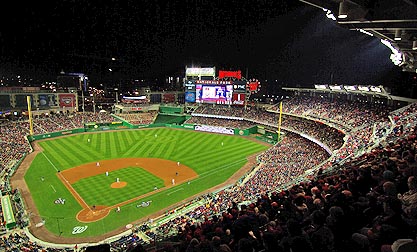 |
That sense of intimacy is aided by the closeness of the upper decks to the field. Following the innovations involving cantilevering the seating decks at Petco Park, Nationals Park does a solid job of keeping the fans — even in the uppermost deck — close to the action (see the photos above and below).
Unlike in San Diego, though, the dimensions of the playing field aren’t cavernous. The power alleys at Nationals Park are 377 feet in left center and 370 in right center (they were both 380 at RFK, and in San Diego they are both 402). In fact, there is an interesting “jog” in the left-centerfield fence in the new park that is meant to imitate the odd configuration of the outfield wall at Griffith Stadium, the Senators’ home from 1911 through 1961. At that classic old park, the fence was built around a tree and dwellings where the property owner refused to sell when the park was being built. At Nationals Park, it was not necessary to do this of course, but it’s always nice when homage is paid to the baseball history of a city.
 |
Now let’s talk about what might be Nationals Park’s enduring legacy in sports architecture, namely how “green” it is. Indeed, although it was largely lost in all of the hysteria about the park’s opening, the fact that the stadium received LEED certification — and at the “Silver” level, not just the minimum level — for its “green” building methods is extraordinary. “The whole design team went above and beyond the call by achieving LEED Silver Certification,” said Stan Kasten, the Nationals’ Team President. “It’s like we asked them for a home run and we got a grand slam.”
One reason this is so special is because Nationals Park is the first major stadium in the country to be awarded this certification … meaning there was no other “green” sports structure to emulate. Joe Spear, the brilliant HOK visionary whose list of accolades and ballpark accomplishments is seemingly endless, remarked that they “had to literally forge a new path in designing a green ballpark.”
Interestingly, many (if not most) of the reasons that Nationals Park achieved the LEED certification are not really noticeable to the fans who attend the games. In fact, it started during the excavation on the site. That’s because 185,087 of the 340,948 cubic yards of soil excavated was deemed to be contaminated and had to be “cleaned” before it could be trucked to a landfill. Ten to twenty percent of the building materials used in constructing the park came from “recycled content.” In addition, care was taken to utilize construction materials from local sources to reduce the pollution that transporting materials long distances would generate. Water-conserving toilet fixtures save over 3 million gallons of water a year. And the filtration system used to treat water — both that’s used to clean the park and the rainwater that falls from the sky — is amazingly sophisticated, which is important since the Anacostia River is a block away.
There are also some aspects of this that might be noticeable to observant fans. For instance, the plants used in the landscaping around the park don’t require enormous amounts of watering, and the lights illuminating the field are particularly energy-efficient. Recycling bins are everywhere around the park. And the use of public transportation is promoted in numerous ways.
Indeed, this is the greenest ballpark in the land — at least until another opens that pushes the envelope (that HOK pioneered here) even further.